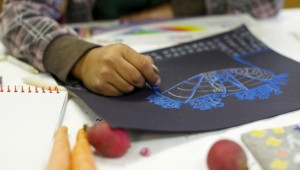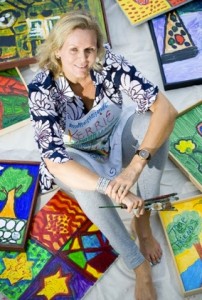 This week ¡Viva el Arte de Santa Bárbara! welcomes Los Vega Son Jarocho, fifth generation jarocho musicians from Veracruz, Mexico. Carrying on a longstanding family tradition, Los Vega brings a fresh pespective to this distinctive style, playing jaranas (small guitars), percussion, vocals and zapateado (footwork).
This week ¡Viva el Arte de Santa Bárbara! welcomes Los Vega Son Jarocho, fifth generation jarocho musicians from Veracruz, Mexico. Carrying on a longstanding family tradition, Los Vega brings a fresh pespective to this distinctive style, playing jaranas (small guitars), percussion, vocals and zapateado (footwork).
According to the organizers, “for more than five generations the Vega family has contributed to traditional son jarocho, taking on the responsibility of keeping a musical expression alive through the generations. Son jarocho is a style of music with origins in music brought from Spain in the colonial period, melded with indiginous folk music, dynamic Afro-Caribbean beats and wise-cracking wordplay unique to the tropical Veracruz region on the Gulf of Mexico. It is music traditionally played on stringed instruments such as the jarana, a strummed guitar with eight to ten strings, three of which are double, and the requinto, a small four-stringed guitar, and is accompanied by intricate dance or zapateado, often performed on wooden platforms or tarimas.”
They will perform a free family concert at Isla Vista School at 7 p.m. on Friday, October 18 (6875 El Colegio Rd., Goleta, 805/893-5037). On Saturday, October 19, they travel to Guadalupe City Hall for a free family concert at 7:30 p.m. (918 Obispo St., Guadalupe, 805/343-2939), returning to Santa Barbara to perform a free family concert at the Marjorie Luke Theatre at Santa Barbara Jr. High on Sunday, October 20 at 7 p.m. (721 E. Cota St., 805/884-4087 x7).
In addition to these performances, on October 17, La Cumbre Jr. High and the Santa Barbara Westside Association co-host a unique opportunity to learn and practice with the musicians of Los Vega Son Jarocho in a free participatory workshop from 5:30–7 p.m. at La Cumbre Jr. High, 2255 Modoc Rd. Musicians and dancers of all levels are welcome to come play together. Please bring your own instrument —or be ready to sing and dance!
Based on a vision of accessible cultural offerings for Santa Barbara County’s Latino communities, ¡Viva el Arte de Santa Bárbara! brings together diverse audiences at free famly events in neighborhood venues on five weekends each year. The program is a consortium of the Marjorie Luke Theatre, the Guadalupe Cultural Arts & Education Center, Isla Vista School, and UCSB Arts & Lectures, represented by co-ordinators Alíz Ruvalcaba, Graciela Parra and Catherine Boyer. Volunteers from PTAs, the California Youth Corps, UCSB sororities and fraternities, and many others, join together to host and staff the events.
¡Viva el Arte de Santa Bárbara! is funded by The James Irvine Foundation and the National Endowment for the Arts with additional support from the SAGE, the Santa Barbara Foundation, Incredible Children’s Art Network, the UCSB Office of Education Partnerships, the Santa Barbara County Arts Commission, The Marjorie Luke Theatre’s Dreier Family Rent Subsidy Fund, the Santa Barbara Independent, Santa Barbara Latino, the Santa Maria SUN, Univisión, the Sandman Inn, Best Western South Coast Inn and Ramada Limited. This project is funded in part by the Community Arts Grant Program using funds provided by the City of Santa Barbara, in partnership with the Santa Barbara County Arts Commission. Co-presented by the Marjorie Luke Theatre, the Guadalupe Arts & Education Center and UCSB Arts & Lectures, in collaboration with the Isla Vista School After School Grant.












